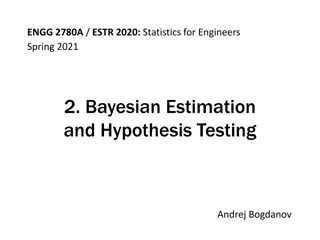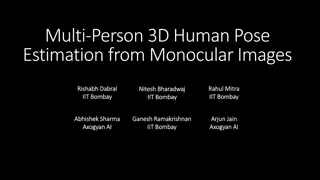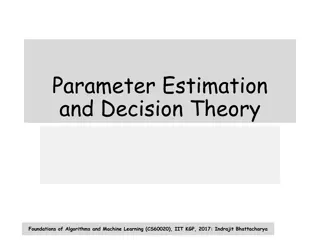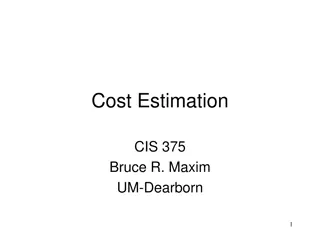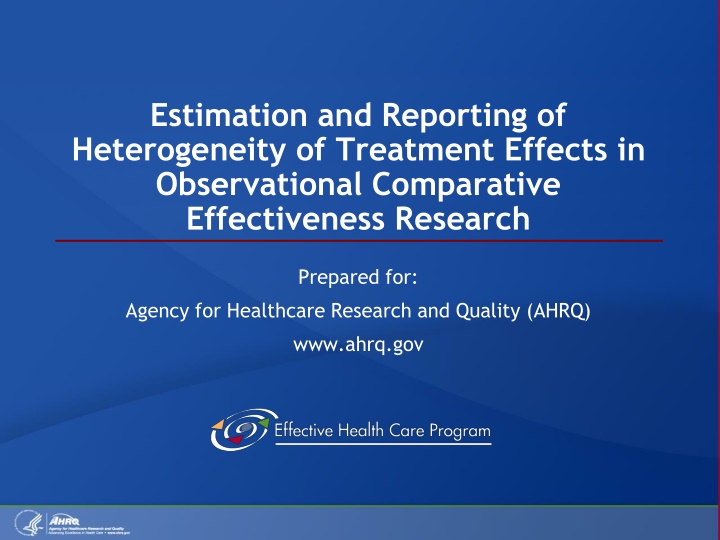
Heterogeneity of Treatment Effects in Comparative Research
Explore the concept of heterogeneity of treatment effects in observational comparative effectiveness research, emphasizing the importance of accounting for individual variations in treatment outcomes. Learn how to identify treatment effect modifiers, pre-specify subgroups for evaluation, address confounding factors, and report overall and subgroup effects.
Download Presentation

Please find below an Image/Link to download the presentation.
The content on the website is provided AS IS for your information and personal use only. It may not be sold, licensed, or shared on other websites without obtaining consent from the author. If you encounter any issues during the download, it is possible that the publisher has removed the file from their server.
You are allowed to download the files provided on this website for personal or commercial use, subject to the condition that they are used lawfully. All files are the property of their respective owners.
The content on the website is provided AS IS for your information and personal use only. It may not be sold, licensed, or shared on other websites without obtaining consent from the author.
E N D
Presentation Transcript
Estimation and Reporting of Heterogeneity of Treatment Effects in Observational Comparative Effectiveness Research Prepared for: Agency for Healthcare Research and Quality (AHRQ) www.ahrq.gov
Outline of Material This presentation will: Summarize prior knowledge on treatment-effect modifiers and reference sources Prespecify subgroups to be evaluated Specify the hypothesized direction of effect within subgroups and the significance levels that will be used to assess statistical significance Describe how confounding will be addressed Describe statistical approaches that will be used to test for interactions for prespecified covariates Describe how overall and subgroup effects will be reported if an interaction test is or is not significant
Introduction Randomized controlled trials (RCTs) and observational comparative effectiveness studies usually report an average treatment effect. However, the same treatment can affect people differently. Restriction of RCTs to homogeneous groups improves statistical power. However, it also contributes to limited generalizability of study results. Determining real-world effects requires additional information and methods.
Heterogeneity of Treatment Effect Nonrandom variability in the direction or magnitude of a treatment effect Important for making decisions based on knowing how well a treatment is likely to work for an individual or group of similar individuals Implications for patients, clinicians, and policymakers Can be observed across different populations (e.g., children, older adults, patients with comorbidities)
Treatment Effect Modification If two or more exposure variables act in concert to cause disease, the effect of exposure on outcome (treatment effect) differs according to the level of the other factor(s). Sound inferences require accounting for factors that modify the effect of the exposure. Perspectives on interaction: Biological Statistical Public health Individual decisionmaking
Goals for Analyzing Heterogeneity of Treatment Effect Analyses of heterogeneity of treatment effect have two main goals: To estimate treatment effects in clinically relevant subgroups (subgroup analysis) To predict whether an individual might benefit from a treatment (predictive learning)
Subgroup Analysis This type of analysis evaluates the treatment effect for a number of subgroups, one variable at a time. A test is conducted to evaluate if a subgroup variable has a statistically significant interaction with the treatment indicator. If the interaction is significant, the treatment effect is estimated separately at each level of the categorical variable. Cautions for tests of interactions: Generally have low power to detect subgroup effects Do not correspond to an assessment of biological interaction
Types of Subgroup Analysis Properties Confirmatory Descriptive Exploratory To test hypotheses related to subgroup effects To report treatment effects for future synthesis To generate hypotheses for further study Goal Number of hypotheses examined A small number, typically one or two Moderate and prespecified Not made explicit, but may be large and not prespecified Prior epidemiological or mechanistic evidence for hypothesis Strong Weak or none Weak or none Prespecification of strategy for data analysis Prespecified in complete detail Prespecified Not prespecified Control of familywise type I error probability Possible, but not essential since the goal is not to test hypotheses Necessary Not essential Characterization of sampling error of the statistical estimator Difficult to characterize sampling properties (e.g., confidence intervals) Easy to achieve Possible Power of testing hypothesis Study may be explicitly designed to have adequate power Likely to be inadequately powered Inadequate power to examine several hypotheses
Potentially Important Subgroup Variables Important subgroups are ones for which limited data are typically available. Subgroup variables must be true covariates (predefined and unaffected by treatment). Additional important subgroup variable types: Demographic Pathophysiologic variables Comorbidities Concomitant exposures Genetic markers
General Considerations for Subgroup Analyses Heterogeneity in observational studies can be due to chance or bias. Evaluate chance findings by testing for interaction. Avoid bias by adhering to sound study design. Observational studies should be designed and analyzed in the same manner as randomized controlled trials to ensure trustworthy results. Stratification on the propensity to receive a medication or strength of indication can identify clinically relevant subgroups. Further investigation is warranted if heterogeneity is observed.
Conclusion Observational studies often have broad inclusion/exclusion criteria. With an increase in generalizability comes the potential for heterogeneity of treatment effects (HTEs). It is important to understand the potential for HTE before conducting observational comparative effectiveness research. It is important to ensure adequate statistical power for confirmatory subgroup analyses. It is necessary to appropriately report the results of an interaction test.
Summary Checklist (1 of 2) Guidance Key Considerations Summarize prior knowledge of treatment effect modifiers and reference sources - Note if priority populations with limited effectiveness data will be included in the study and evaluated as subgroups - Subgroups should be defined by variables measured at baseline or variables known to be unaffected by exposure - If confirmatory analyses, do power calculations Specify the hypothesized direction of effect within subgroups and the significance levels that will be used to assess statistical significance - Describe methods to adjust for multiple testing, if applicable Describe how confounding will be addressed - Assess covariate balance between the treatment groups within each stratum of the subgrouping variable
Summary Checklist (2 of 2) Guidance Key Considerations Describe statistical approaches that will be used to test for interactions for prespecified covariates - If the interaction test is not significant: - Report the average treatment effect (ATE) - Discuss plausible reasons for null findings in relation to other studies and plausible biological mechanism Describe how overall (ATE) and subgroup effects will be reported if the interaction test is or is not significant - Clearly distinguish subgroup results as confirmatory, descriptive, or exploratory analyses Report subgroup effects in a table and/or a forest plot with a vertical line representing the overall treatment effect (ATE) -


